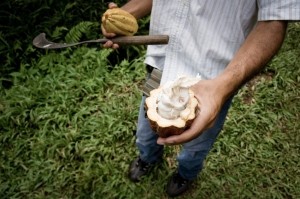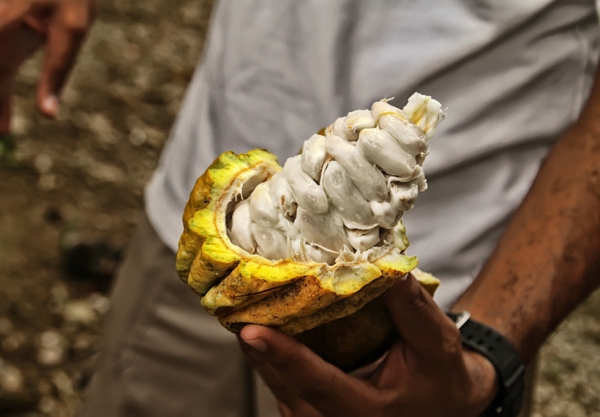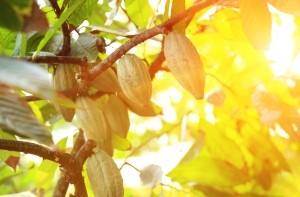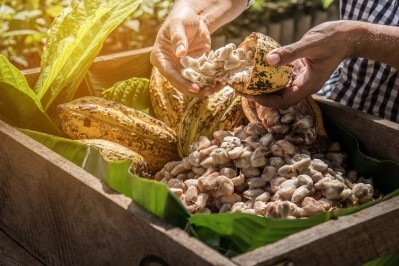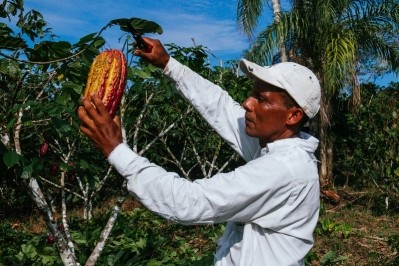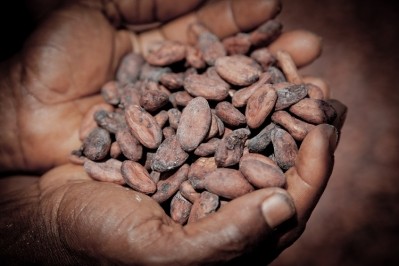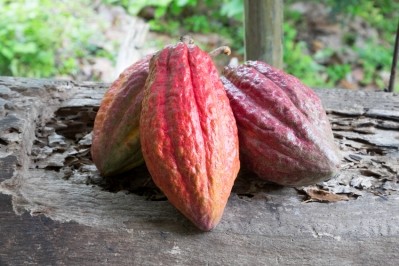Reaching the ‘left behind’: Systemic solutions needed to tackle farmer poverty in cocoa
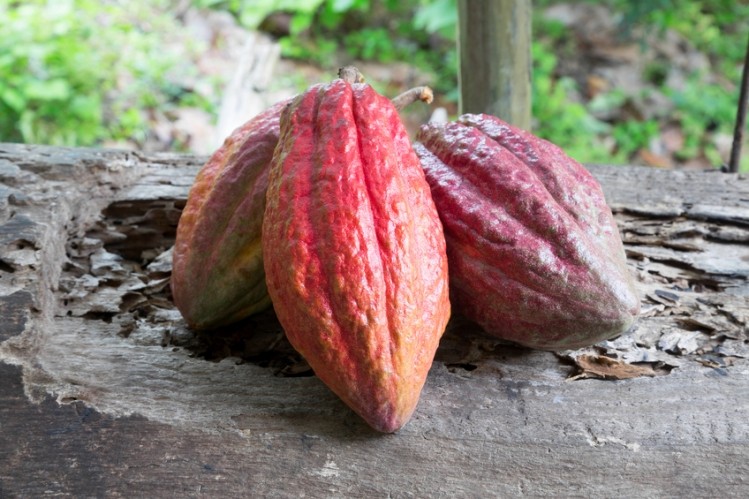
Côte d'Ivoire and Ghana produce 60% of the world’s cocoa each year. The sector supports around 2m farmers in the region. But extreme poverty is endemic. The average cocoa farmer in these countries lives on less than $1.50 a day – below the World Bank’s international poverty line of $1.90 a day.
Farmer poverty is an important element for CSR initiatives in the chocolate sector. Multinationals and NGOs alike operate outreach programs focused on raising farmer income and tackling some of the worst consequences of the extreme poverty witnessed in the industry – including child labour and deforestation.
However, a new report from the Fairtrade Foundation and Mondelez International reveals a concerning trend.
The total number of farmers reported to be targeted across all initiatives exceeds the estimated number of cocoa farmers present in the region by almost 800,000. Less than 50% of programs combined claim to work with over 150% of farmers estimated in the country.
Rather than suggesting cocoa farmers are well-served by sustainability programs, the data actually indicate that a lack of coordination has led to duplication, the researchers concluded. Some farmers, it transpires, attend multiple education workshops organized by the sustainable cocoa projects of multinational chocolate companies.
“We heard from the farmers themselves that they often attend multiple training events from different programs, only to hear the same information again and again. This lack of coordination is quite obviously a waste of valuable resources for all concerned,” Fairtrade Foundation director of impact Louisa Cox noted.
According to the research, the Cocoa Sustainable Livelihoods Landscape Study, as many as 1.69m farmers are being left out. And these farmers are likely to be the most vulnerable – those that are in poor growing regions where multinationals do not operate and those that are not part of farmer organisations. “Farmers that are not part of cooperatives are not served by initiatives because the programs can’t reach them. That is somewhere between 1 and 1.7m farmers that are outside cooperatives and hot spot regions, where production is naturally high and the quality of cocoa is good,” Cox told FoodNavigator.
Fairtrade Foundation and Mondelez hope that the joint study will form a springboard for increased collaboration between different players in the cocoa sector. “We as a sector must make partnerships work in new and better ways. Currently, there is considerable overlap between livelihood initiatives, with many clearly focusing on the same farmer groups but without any overall coordination,” Cox stressed.
Tip of the iceberg?
In fact, the situation on the ground could be much worse. Cathy Pieters, who heads up Mondelez’s Cocoa Life program, said that the study did not have ‘a lot of access’ to indirect suppliers and the findings are ‘more about the different forms of production within the direct supply chain’.
This ‘absolutely’ implies that the scale of the problem is far greater than the study suggests, she noted.
According to analysts at data and insight provider Lumina Intelligence, owned by FoodNavigator publisher William Reed Business Media, direct suppliers likely account for less than 50% of all farmers. The rest are indirect suppliers, smallholder farmers that sell low volumes of cocoa to middlemen. Poverty, and all associated consequences, are much bigger problems for those operating in the indirect supply chain.
“We need to find a solution,” Pieters said. But the complex and opaque nature of the supply chain is a significant challenge.
In the indirect supply chain, cocoa will often pass from smallholder farmers in remote areas, to small-scale middlemen who collect the cocoa on motorbikes and sell it on to a larger middleman. The commodity will then be passed to large multinational cocoa companies, who do not have traceability for that volume of cocoa. From these ingredient suppliers, it will then make its way into the supply chains of the large global chocolate companies.
For Pieters, increased transparency is a vital ‘building block’ if the chocolate sector is to develop a coordinated approach to bring farmers currently excluded from sustainability and education initiatives into the fold.
“Today a big chunk of the farmers in Côte d'Ivoire are unknown, even by the government. It's very difficult for any player in the industry to work with these individual farmers if it is difficult to understand where they are. We are asking governments to create transparency. When we talk about a sector wide strategy that is a building block.
“Things need to happen at the same time. If we push too much in one direction and we don’t move from an opaque into a fully transparent value chain we might lose some of those non-visible farmers.”
Increasing transparency: challenges and opportunities
What tools are needed to increase transparency and traceability in cocoa?
Some companies, particularly in their efforts to stamp out deforestation in their supply chains, have adopted new technologies like satellite monitoring. However, indirect suppliers and smallholders often grow cocoa under canopy cover, making it difficult to detect deforestation in this way.
Another barrier to increased collaboration is an unwillingness among operators in the sector to share data that could be viewed as commercially sensitive. Without this data sharing, it is difficult to see how a joined-up sector wide approach can be developed.
In the search for a solution, Pieters believes that governance holds the key. “There is a sensitivity around data. But we also believe if the governance is better understood it is easier to focus on the right data. I sometimes believe that there is way too much data and we are not able to digest it all to inform in an effective way a sector-wide strategy. Because that is what we need to solve. We need a sector wide strategy that is informed by the right data pieces and experiences that provides fertile ground for coordinated data.”
She suggested that the governments in cocoa producing countries could play a vital role here. But it would take ‘political will’ from their side. “From a government perspective, you need to want to open up that whole piece and at least make sure everybody is known and we all have access to that information. That is the starting point.
“The second piece, if we assume transparency… we need to make sure farmer organisations are strong and have the possibility to drive their own development and sustainability. I am saying farmer organisations because we know in some regions there is push back on cooperatives. We need to be open minded on how farmers want to be organised.”
‘There needs to be a real dialog’
The report also concluded that there is a disconnect between the short-term goals of farmers and the long-term ambitions of existing farmer education and sustainability initiatives. As a result of a top-down approach, these programs don’t always reflect the priorities of farmers, the report concluded.
Currently, the majority of sustainability work – 83% of existing initiatives - focus on farmer productivity. Most do not engage deeply on how to improve general market structures and processes, such as systemic lack of formal and longer-term contracts. Currently only 7% of all initiatives focus on these wider interconnected issues, the researchers found.
“All the initiatives have the right intentions. Potentially what has happened is there has been a disconnect between what farmer families and households feel as their priorities and what program owners understand to be the priorities - and are heavily challenged on by civil society and journalists on," Pieters told this publication.
The result is that while cocoa sourcing programs may focus on big picture issues like deforestation or climate change, farmers' true concerns are more likely to concentrate on sending their children to school and feeding their families.
How can these distinct – but complimentary – approaches be brought together? “There needs to be a real dialog. We need to facilitate that, maybe also through government platforms,” the Mondelez cocoa sourcing expert suggested.
“I spend a lot of time in the fields. When you mention climate change people might say ‘I first want to make sure my kids can go to school, that I have food tomorrow, and that I have electricity in my village’. But if you engage longer [the aligned nature of these goals becomes evident]. ‘Have you noticed that the rain is going away? Your younger children want to go to the city because it’s too hot, and you know why that is’. If you have that dialogue things start to be connected. If we want to stay relevant, we have to have that connection.”
Why not pay more for cocoa?
The United Nation’s Sustainable Development Goal number one is the eradication of poverty. Farmer incomes are ‘one of the first KPIs’ in Mondelez’s Cocoa Life program. This priority is also evident in the cocoa initiatives of the company’s peer group in the chocolate sector.
The current trading system for cocoa sees farmers paid low prices and exposed to the volatility of commodity markets. And yet, almost all industry sustainability programs focus on productivity rather than price. Should the cocoa sector accept that it has a responsibility to pay higher prices for cocoa so that farmers can achieve an income above the international poverty line?
Pieters believes this is a gross oversimplification. She said that Mondelez supports the living income differential (LID) recently introduced by West African neighbours Côte d'Ivoire and Ghana to support cocoa incomes. “We are totally embracing the LID – it is baked into our strategic planning and we will pay for that.”
However, she continued, Mondelez’s data suggest that this approach fails to deliver the desired impact and potentially exasperates the situation of those left behind farmers that operate small farms and exist in the informal supply chain.
“We have been gathering impact data for years. That data, but also the work we are doing with the Living Income Community of Practice [ISEAL], the Royal Tropical Institute or Wageningen University, all leads us to know only an interlinked and systemic approach can make a sustainable shift. Just addressing paying more is not going to make a sustainable shift for enough farmers… There needs to be an interlinked answer and it needs to be addressed at different levels.
“Just looking at paying more in isolation is going to be very disappointing. Only a small number of people will reach that level – a big chunk of people will not be able to get out of poverty.”
For the Fairtrade Foundation, Cox said price is an important piece of the puzzle. However, she too stressed that this can only go so far to solving the problems in the cocoa supply chain. Increase the price, she suggested, and inequality is likely to increase.
“We have done a lot of work on living income. Price for us is important. If farmers were paid $2,200 per ton instead of the current farmgate price of $1,400 they would achieve a living income. That benchmark is useful in terms of showing the size of the living income gap.
“But that said, it doesn’t tell you what the journey is. What is the pathway there? Price is important. But it’s certainly not everything because that living income reference price is based on your ‘average farmer’. If your average farmer has five hectares of land and 800 kilos of cocoa per hectare, paying them $2200 per ton will give them a living income. But most farmers are not your average farmers. The situation is way more complex. And that is exactly why we are trying to mobilise the sector behind the challenge.”
